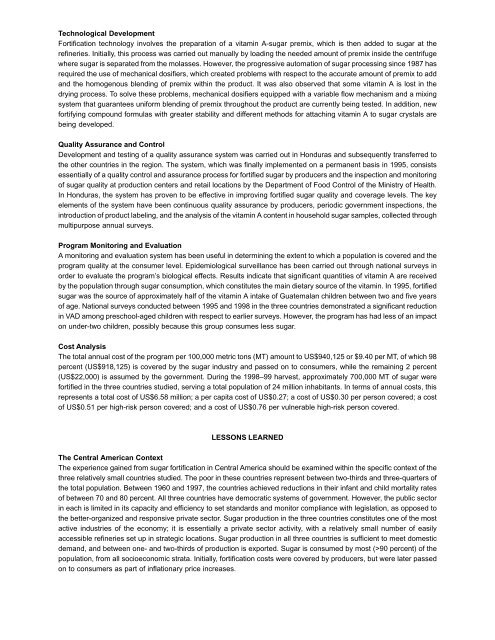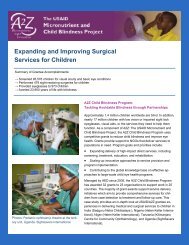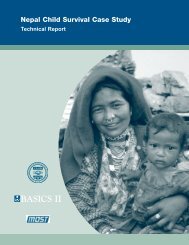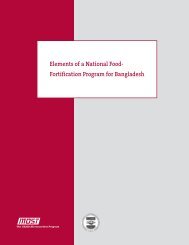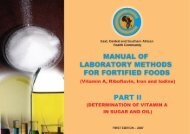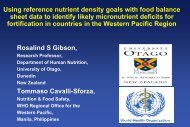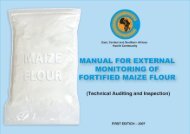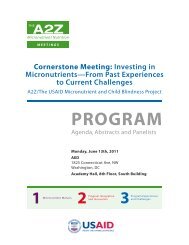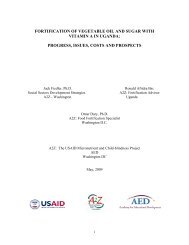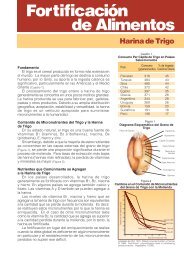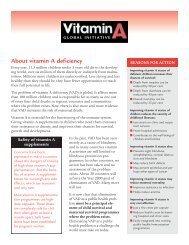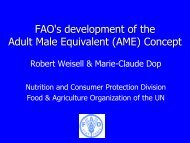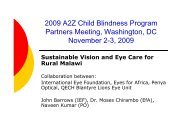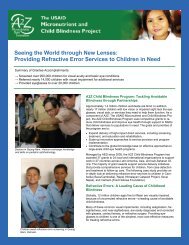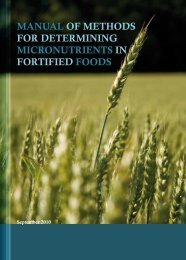Vitamin A Sugar Fortification in Central America - A2Z: The USAID ...
Vitamin A Sugar Fortification in Central America - A2Z: The USAID ...
Vitamin A Sugar Fortification in Central America - A2Z: The USAID ...
- No tags were found...
You also want an ePaper? Increase the reach of your titles
YUMPU automatically turns print PDFs into web optimized ePapers that Google loves.
Technological Development<strong>Fortification</strong> technology <strong>in</strong>volves the preparation of a vitam<strong>in</strong> A-sugar premix, which is then added to sugar at theref<strong>in</strong>eries. Initially, this process was carried out manually by load<strong>in</strong>g the needed amount of premix <strong>in</strong>side the centrifugewhere sugar is separated from the molasses. However, the progressive automation of sugar process<strong>in</strong>g s<strong>in</strong>ce 1987 hasrequired the use of mechanical dosifiers, which created problems with respect to the accurate amount of premix to addand the homogenous blend<strong>in</strong>g of premix with<strong>in</strong> the product. It was also observed that some vitam<strong>in</strong> A is lost <strong>in</strong> thedry<strong>in</strong>g process. To solve these problems, mechanical dosifiers equipped with a variable flow mechanism and a mix<strong>in</strong>gsystem that guarantees uniform blend<strong>in</strong>g of premix throughout the product are currently be<strong>in</strong>g tested. In addition, newfortify<strong>in</strong>g compound formulas with greater stability and different methods for attach<strong>in</strong>g vitam<strong>in</strong> A to sugar crystals arebe<strong>in</strong>g developed.Quality Assurance and ControlDevelopment and test<strong>in</strong>g of a quality assurance system was carried out <strong>in</strong> Honduras and subsequently transferred tothe other countries <strong>in</strong> the region. <strong>The</strong> system, which was f<strong>in</strong>ally implemented on a permanent basis <strong>in</strong> 1995, consistsessentially of a quality control and assurance process for fortified sugar by producers and the <strong>in</strong>spection and monitor<strong>in</strong>gof sugar quality at production centers and retail locations by the Department of Food Control of the M<strong>in</strong>istry of Health.In Honduras, the system has proven to be effective <strong>in</strong> improv<strong>in</strong>g fortified sugar quality and coverage levels. <strong>The</strong> keyelements of the system have been cont<strong>in</strong>uous quality assurance by producers, periodic government <strong>in</strong>spections, the<strong>in</strong>troduction of product label<strong>in</strong>g, and the analysis of the vitam<strong>in</strong> A content <strong>in</strong> household sugar samples, collected throughmultipurpose annual surveys.Program Monitor<strong>in</strong>g and EvaluationA monitor<strong>in</strong>g and evaluation system has been useful <strong>in</strong> determ<strong>in</strong><strong>in</strong>g the extent to which a population is covered and theprogram quality at the consumer level. Epidemiological surveillance has been carried out through national surveys <strong>in</strong>order to evaluate the program’s biological effects. Results <strong>in</strong>dicate that significant quantities of vitam<strong>in</strong> A are receivedby the population through sugar consumption, which constitutes the ma<strong>in</strong> dietary source of the vitam<strong>in</strong>. In 1995, fortifiedsugar was the source of approximately half of the vitam<strong>in</strong> A <strong>in</strong>take of Guatemalan children between two and five yearsof age. National surveys conducted between 1995 and 1998 <strong>in</strong> the three countries demonstrated a significant reduction<strong>in</strong> VAD among preschool-aged children with respect to earlier surveys. However, the program has had less of an impacton under-two children, possibly because this group consumes less sugar.Cost Analysis<strong>The</strong> total annual cost of the program per 100,000 metric tons (MT) amount to US$940,125 or $9.40 per MT, of which 98percent (US$918,125) is covered by the sugar <strong>in</strong>dustry and passed on to consumers, while the rema<strong>in</strong><strong>in</strong>g 2 percent(US$22,000) is assumed by the government. Dur<strong>in</strong>g the 1998–99 harvest, approximately 700,000 MT of sugar werefortified <strong>in</strong> the three countries studied, serv<strong>in</strong>g a total population of 24 million <strong>in</strong>habitants. In terms of annual costs, thisrepresents a total cost of US$6.58 million; a per capita cost of US$0.27; a cost of US$0.30 per person covered; a costof US$0.51 per high-risk person covered; and a cost of US$0.76 per vulnerable high-risk person covered.LESSONS LEARNED<strong>The</strong> <strong>Central</strong> <strong>America</strong>n Context<strong>The</strong> experience ga<strong>in</strong>ed from sugar fortification <strong>in</strong> <strong>Central</strong> <strong>America</strong> should be exam<strong>in</strong>ed with<strong>in</strong> the specific context of thethree relatively small countries studied. <strong>The</strong> poor <strong>in</strong> these countries represent between two-thirds and three-quarters ofthe total population. Between 1960 and 1997, the countries achieved reductions <strong>in</strong> their <strong>in</strong>fant and child mortality ratesof between 70 and 80 percent. All three countries have democratic systems of government. However, the public sector<strong>in</strong> each is limited <strong>in</strong> its capacity and efficiency to set standards and monitor compliance with legislation, as opposed tothe better-organized and responsive private sector. <strong>Sugar</strong> production <strong>in</strong> the three countries constitutes one of the mostactive <strong>in</strong>dustries of the economy; it is essentially a private sector activity, with a relatively small number of easilyaccessible ref<strong>in</strong>eries set up <strong>in</strong> strategic locations. <strong>Sugar</strong> production <strong>in</strong> all three countries is sufficient to meet domesticdemand, and between one- and two-thirds of production is exported. <strong>Sugar</strong> is consumed by most (>90 percent) of thepopulation, from all socioeconomic strata. Initially, fortification costs were covered by producers, but were later passedon to consumers as part of <strong>in</strong>flationary price <strong>in</strong>creases.


